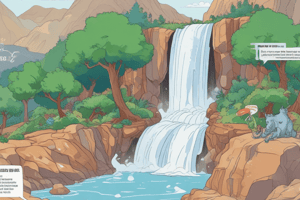Podcast
Questions and Answers
Software costs often dominate computer system costs.
Software costs often dominate computer system costs.
True (A)
Agile-driven processes are processes where all the process activities are planned in advance and progress is measured against this plan.
Agile-driven processes are processes where all the process activities are planned in advance and progress is measured against this plan.
False (B)
The waterfall model is a plan-driven model.
The waterfall model is a plan-driven model.
True (A)
In incremental development model, specification, development, and validation are not interleaved.
In incremental development model, specification, development, and validation are not interleaved.
Software engineering focuses on theory and fundamentals while computer science is concerned with the practicalities of developing and delivering useful software.
Software engineering focuses on theory and fundamentals while computer science is concerned with the practicalities of developing and delivering useful software.
In the waterfall model, the cost of accommodating changing customer requirements is reduced.
In the waterfall model, the cost of accommodating changing customer requirements is reduced.
The waterfall model is only appropriate when the requirements are well understood, and changes will be fairly limited during the design process.
The waterfall model is only appropriate when the requirements are well understood, and changes will be fairly limited during the design process.
System engineering is a part of the software engineering process.
System engineering is a part of the software engineering process.
In generic software, the specification of what the software should do is owned by the software developer.
In generic software, the specification of what the software should do is owned by the software developer.
Change is inevitable in all large software projects.
Change is inevitable in all large software projects.
User requirements are mainly written for the customers.
User requirements are mainly written for the customers.
System requirements are mainly written for the customers.
System requirements are mainly written for the customers.
Agile methods usually aim to produce detailed system requirements.
Agile methods usually aim to produce detailed system requirements.
It is easy to produce a complete and consistent requirements document.
It is easy to produce a complete and consistent requirements document.
Requirements consistency means that the requirements should include descriptions of all facilities required.
Requirements consistency means that the requirements should include descriptions of all facilities required.
Requirements consistency means that the requirements have no conflicts in the descriptions of the system facilities.
Requirements consistency means that the requirements have no conflicts in the descriptions of the system facilities.
Non-functional requirements may be more critical than functional requirements.
Non-functional requirements may be more critical than functional requirements.
Non-functional requirements can be ignored during the development of the system.
Non-functional requirements can be ignored during the development of the system.
A goal is a statement using some measure that can be objectively tested.
A goal is a statement using some measure that can be objectively tested.
Closed interviews depend on a predetermined list of questions.
Closed interviews depend on a predetermined list of questions.
Open interviews depend on a predetermined list of questions.
Open interviews depend on a predetermined list of questions.
Flashcards are hidden until you start studying
Study Notes
Software Engineering
- Software costs often outweigh other hardware costs associated with computer systems.
- Agile software development processes are iterative and responsive to change.
- The Waterfall model is a plan-driven, linear approach to software development.
- In Incremental models, development phases are interleaved; design, specification, and validation happen simultaneously.
- Software Engineering focuses on practical application, while Computer Science focuses on theory and fundamentals.
- The Waterfall model is not suitable for projects with evolving requirements due to the high cost of change implementation.
- System engineering addresses the overall development of a system where software engineering is one component.
- Generic software specifications are controlled by the software developer.
- Change is a constant in large software projects.
- User requirements are intended for users, while System requirements are meant for developers.
- Agile methods prioritize flexibility and rapid feedback rather than detailed upfront documentation.
- Building complete, consistent, and accurate requirements documents is a complex process.
- Requirements consistency means that the requirements should not contradict each other.
- Non-functional requirements are as crucial as functional requirements, and can influence the overall quality and success of software.
- Objectives are measurable statements, while goals are broader and less concrete in measurement.
- Closed interviews use pre-defined questions for a structured approach, while open interviews allow for flexibility and open-ended discussions
Studying That Suits You
Use AI to generate personalized quizzes and flashcards to suit your learning preferences.




